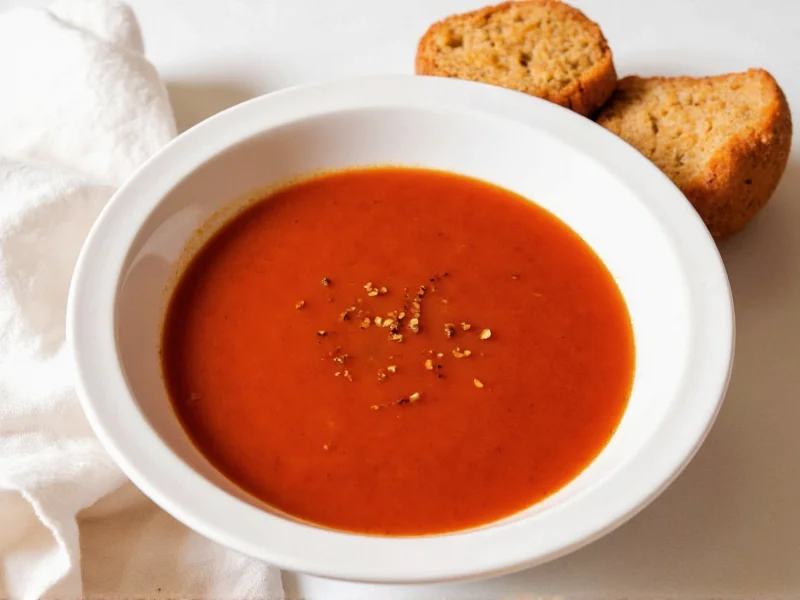Creating delicious tomato soup from tomato sauce is one of the easiest kitchen transformations you can make. This method bypasses the lengthy process of simmering fresh tomatoes while delivering a consistently flavorful result. Whether you're looking for a quick weeknight meal or pantry-friendly comfort food, this approach solves the common problem of having tomato sauce but craving proper soup.
Why Tomato Sauce Makes the Perfect Soup Base
Tomato sauce already contains cooked, strained tomatoes with seasonings, giving you a head start compared to starting from raw ingredients. Unlike tomato paste which requires significant liquid addition, tomato sauce has the ideal consistency that only needs minor adjustments to become soup. This easy tomato soup recipe using tomato sauce eliminates hours of simmering while maintaining depth of flavor.
Essential Ingredients for Perfect Tomato Soup
What makes this quick tomato soup from canned tomato sauce exceptional is using quality ingredients in precise proportions:
| Ingredient | Amount | Why It Matters |
|---|---|---|
| Tomato sauce (plain) | 1 (15 oz) can | Provides cooked tomato base without added sugar or herbs |
| Vegetable broth | 1 cup | Enhances flavor complexity without overpowering |
| Heavy cream or coconut milk | 1/4 cup | Adds richness and balances acidity |
| Fresh garlic, minced | 1 large clove | Essential aromatic foundation |
| Dried basil | 1 tsp | Complements tomato flavor without overpowering |
| Salt and pepper | To taste | Final flavor adjustment |
Step-by-Step Preparation
Follow these precise steps for homemade tomato soup with tomato sauce base that rivals restaurant versions:
- Sauté aromatics: In a medium saucepan over medium heat, melt 1 tablespoon of butter. Add minced garlic and sauté for 1 minute until fragrant but not browned.
- Combine liquids: Pour in the tomato sauce and vegetable broth, stirring to combine thoroughly. Avoid using water as it dilutes flavor.
- Add seasonings: Stir in dried basil, 1/2 teaspoon salt, and 1/4 teaspoon black pepper. Bring to a gentle simmer.
- Simmer for depth: Reduce heat to low and let the soup simmer uncovered for 15 minutes, allowing flavors to meld.
- Finish with cream: Remove from heat and stir in cream or coconut milk. For ultra-smooth texture, use an immersion blender directly in the pot.
- Final adjustment: Taste and adjust salt, pepper, or add a pinch of sugar if tomatoes are too acidic.
Avoiding Common Mistakes
Many home cooks encounter issues with how to thicken tomato soup from sauce or balancing flavors. Prevent these problems:
- Don't boil vigorously: High heat after adding dairy causes separation. Always simmer gently.
- Avoid over-blending hot soup: If using a countertop blender, cool slightly and blend in batches with the lid slightly ajar.
- Don't skip the acid balance: A small pinch of sugar (1/4 tsp) counteracts excessive tomato acidity without making soup sweet.
- Resist adding too much liquid: Tomato sauce already has ideal consistency; adding excessive broth creates watery soup.
Customization Options for Different Diets
This vegetarian tomato soup from tomato sauce easily adapts to various dietary needs:
- Vegan version: Substitute coconut milk for cream and ensure broth is vegan
- Lower sodium: Use no-salt-added tomato sauce and low-sodium broth
- Extra protein: Stir in 1/2 cup white beans after blending for added nutrition
- Spicy variation: Add 1/4 teaspoon red pepper flakes with the garlic
Storage and Reheating Instructions
Proper storage maintains the quality of your simple pantry tomato soup recipe:
- Cool completely before storing in airtight containers
- Refrigerate for up to 4 days or freeze for 3 months
- Reheat gently on stove over medium-low heat, stirring occasionally
- Never boil when reheating to prevent dairy separation
- Add a splash of broth when reheating if soup has thickened too much
Why This Method Works Better Than Starting From Scratch
Using tomato sauce as your foundation provides consistent results that homemade versions from fresh tomatoes often lack. Commercial tomato sauce undergoes controlled cooking that develops flavor compounds difficult to replicate at home in short timeframes. This how to make tomato soup without fresh tomatoes approach delivers reliable texture and flavor every time while cutting preparation time by 75% compared to traditional methods.
Can I use tomato sauce with added herbs for this recipe?
Yes, but adjust additional seasonings accordingly. If your sauce contains Italian herbs, reduce or eliminate added basil. For garlic-flavored sauce, decrease the fresh garlic quantity to avoid overpowering the soup.
How do I fix tomato soup that's too acidic?
Add 1/4 teaspoon of sugar or a small pinch of baking soda (1/16 teaspoon) to neutralize excess acidity. Stir well and taste before adding more. Dairy ingredients like cream also naturally balance tomato acidity.
What's the best way to achieve restaurant-style smoothness?
Use an immersion blender directly in the pot for safest results with hot soup. If using a countertop blender, cool the soup slightly, fill only halfway, and remove the center cap to allow steam to escape while blending.
Can I make this soup gluten-free?
Yes, this recipe is naturally gluten-free as long as you verify your tomato sauce and broth are certified gluten-free. Most plain tomato sauces don't contain gluten, but always check labels if you have sensitivity.
How can I add more depth without additional ingredients?
Let the soup simmer uncovered for 5-10 minutes longer to concentrate flavors. A small splash (1 tablespoon) of balsamic vinegar added at the end also enhances complexity without changing the fundamental flavor profile.











 浙公网安备
33010002000092号
浙公网安备
33010002000092号 浙B2-20120091-4
浙B2-20120091-4